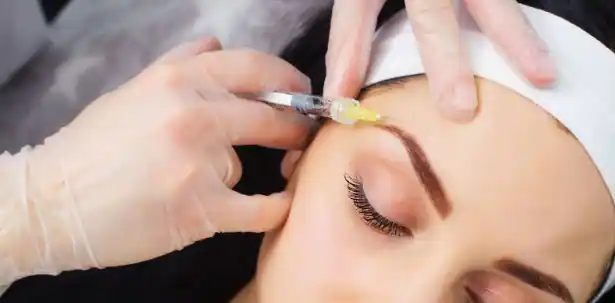Welcome to our blog post on the topic that has everyone raising their eyebrows – forehead wrinkles! If you’ve noticed those pesky lines starting to form across your forehead, don’t fret. You’re not alone. Forehead wrinkles are a common concern for many people as they age, and luckily, there’s a popular solution that can help smooth them away: Botox.
In this article, we’ll explore everything you need to know about determining how many units of Botox for forehead wrinkles. From understanding different types of wrinkles to consulting with a professional and maintaining your results, we’ve got you covered. So let’s get started on your journey towards a smoother and more youthful-looking forehead!
Understanding Forehead Wrinkles
Forehead wrinkles, also known as “worry lines” or “expression lines,” are the result of repetitive muscle movements and natural aging processes. These lines can appear horizontally across the forehead or vertically between the eyebrows, giving our faces a tired or aged appearance.
There are various factors that contribute to the development of forehead wrinkles. First and foremost is age – as we get older, our skin loses elasticity and collagen production slows down, making it more prone to wrinkling. Additionally, sun exposure plays a significant role in premature aging and wrinkle formation.
But it’s not just external factors that contribute to forehead wrinkles; our facial expressions play a part too! Repetitive movements like furrowing your brows when concentrating or squinting in bright sunlight can lead to deep-set creases over time.
It’s important to note that there are different types of forehead wrinkles. Dynamic wrinkles occur when you make specific facial expressions, while static wrinkles are present even at rest. Understanding which type you have will help determine the appropriate treatment approach.
Now that we have a better understanding of what causes those pesky forehead wrinkles let’s explore how Botox can come into play as an effective solution for smoothing them away. But remember, consulting with a professional is crucial before diving into any treatments!
Factors That Affect The Number Of Botox Units Needed
- Treatment Area: Different areas of the face and body require different amounts of Botox. For example, treating forehead wrinkles typically requires fewer units than addressing crow’s feet or frown lines.
- Muscle Strength: The strength and activity of the muscles being treated play a significant role. Stronger muscles may require more Botox to achieve the desired effect.
- Patient’s Age: Older patients may require more Botox units to achieve the same result as younger patients due to the natural aging process and changes in muscle tone.
- Treatment Goals: The extent to which a patient wants to reduce wrinkles and lines can also influence the dosage. Some patients prefer a more subtle effect, while others want a more dramatic change.
- Individual Variation: Each person’s anatomy is unique, and the way their muscles respond to Botox can vary. Factors such as muscle size, skin thickness, and genetic factors can all impact the required dosage.
- Previous Botox Treatments: If a patient has had previous Botox treatments, it may influence the number of units needed. Frequent treatments can lead to muscle atrophy, reducing the amount of Botox required over time.
- Injector’s Skill and Experience: The experience and expertise of the healthcare professional administering the Botox can affect the outcome. An experienced injector can often achieve better results with fewer units.
- Desired Duration: The longevity of the results can be influenced by the number of units used.
- Patient’s Gender: In some cases, men may require more Botox units than women due to differences in muscle mass and facial anatomy.
- Severity of Wrinkles: The severity of wrinkles and lines being treated can also impact the dosage. Deeper lines may require more Botox units.
Recommended Dosage For Different Types Of Forehead Wrinkles
When it comes to treating forehead wrinkles with Botox, the dosage needed can vary depending on the type and severity of the wrinkles. It’s important to note that only a qualified professional should determine the appropriate dosage for each individual case.
Moderate to severe horizontal forehead lines may require a higher dosage. These deeper wrinkles often result from years of muscle contractions and can be more challenging to treat effectively. A range of 20-30 units or even slightly higher might be advised in these cases.
Vertical frown lines between the eyebrows are another common concern that can contribute to an aged appearance. The recommended dose will depend on factors such as their depth and prominence. Typically, around 15-25 units are used for this area https://spablack.com.
It’s crucial to remember that everyone’s anatomy and facial expressions differ, so there is no one-size-fits-all approach when it comes to using Botox for forehead wrinkles. Consulting with a skilled professional who understands your unique needs is essential for determining the right dosage tailored specifically for you.
The Importance Of Consulting with A Professional
When it comes to getting how many units of Botox for forehead wrinkles, consulting with a professional is absolutely crucial. While it may be tempting to try and administer the treatment yourself or seek out cheaper alternatives, doing so can lead to serious complications and unsatisfactory results.
A qualified professional will have the necessary expertise and experience to assess your specific needs and determine the appropriate number of how many units of Botox for forehead required for your forehead wrinkles. They will consider factors such as the depth and severity of your wrinkles, as well as any underlying muscle activity that may affect the dosage.
By consulting with a professional, you also gain access to their knowledge about other treatments that may complement or enhance your desired outcome. They can provide valuable advice on skincare routines, lifestyle changes, and preventative measures that can help maintain optimal results.
Investing in a consultation with a skilled professional ensures that you receive personalized care tailored specifically to your unique needs. Don’t compromise on quality when it comes to something as important as altering your appearance – trust an expert who has dedicated their career to helping people look and feel their best.
Tips For Maintaining Results
1. Follow post-treatment instructions: Your healthcare professional will provide you with specific guidelines to follow after your Botox treatment. It’s important to adhere to these instructions, which may include avoiding strenuous exercise, not touching or massaging the treated area, and avoiding excessive sun exposure.
2. Protect your skin from the sun: Sun exposure can accelerate the breakdown of collagen and elastin in the skin, leading to premature aging and wrinkles. To maintain your Botox results, wear sunscreen daily with a high SPF and seek shade during peak hours.
3. Practice good skincare routine: A consistent skincare routine can complement the effects of Botox by keeping your skin healthy and nourished. Use gentle cleansers, moisturizers, and anti-aging serums that suit your skin type.
4. Stay hydrated: Proper hydration is crucial for maintaining plump and supple skin.
5. Avoid smoking and excessive alcohol consumption: Smoking damages collagen production while excessive alcohol consumption dehydrates the body, both contributing factors in accelerating aging signs like forehead wrinkles.
6. Consider touch-up treatments: While individual results may vary based on various factors such as metabolism and lifestyle choices, scheduling regular touch-up appointments with an experienced professional can help sustain optimal outcomes over time.
Conclusion
Determining the number of Botox units needed for forehead wrinkles can vary depending on several factors. It is important to understand that each individual’s needs and desired results are unique. Consulting with a professional who has expertise in administering Botox injections is crucial in order to achieve optimal results. Factors such as the severity of wrinkles, muscle strength, and individual anatomy all play a role in determining the recommended dosage. A skilled practitioner will assess these factors during a consultation and create a personalized treatment plan tailored to your specific needs.
Botox can be an effective solution for reducing forehead wrinkles when administered by a qualified professional. By understanding the various factors involved in determining the appropriate number of units required for your specific concerns, you can make informed decisions about your treatment options.


